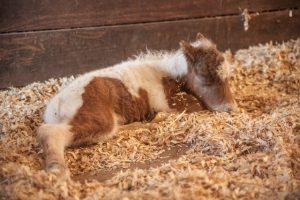Are you mulling over your horse’s stall maintenance, wondering which bedding is healthiest and offers the best bang for the buck? You’re not alone. Equine scientists recently compared three types of bedding in three critical categories—ammonia emissions, cost, and mucking out time—to help horse owners choose the best bedding.
Bedding materials serve many functions, such as absorbing urine and ammonia, which is produced during the breakdown of urine in the environment; providing cushioning for standing and recumbent horses; and offering thermal insulation.
“Of those, absorbing urine and ammonia is of particular importance because ammonia irritates the respiratory tract and may contribute to inflammatory airway disease and equine asthma. In addition, the dust generated from some beddings can exacerbate, perhaps even cause, asthma in many horses,” explained Catherine Whitehouse, M.S., of Kentucky Equine Research.
In addition to health considerations, the economic aspects of bedding should be considered. Bedding is a major expense for equine operations and mucking out stalls is labor intensive.
In one study, three different beddings were compared: sawdust, pinewood shavings, and rubber wood shavings.* Rubber wood shavings and sawdust were local products of Malaysia, where the study was conducted, and the pinewood shavings were imported.
Key findings were:
- Pinewood shavings had the greatest urine-holding capacity of the three beddings;
- Pinewood shavings released significantly less ammonia than the other two types of bedding;
- Sawdust was the least expensive but greater quantities of bedding were used;
- Sawdust took significantly longer for workers to muck out the stalls, as it was messier, dustier, and harder to clean due to its small particles.
Researchers observed no differences in comfort between the three types of beddings.
The goal of this study was not to specifically recommend pinewood shavings but simply to raise awareness regarding the pros and cons associated with different types of bedding.
“Bedding choice can affect both horse and caretaker health. Material that absorbs urine while producing minimal waste is preferred because these types of bedding reduce labor and minimize waste handling while creating a healthier stable environment. Frequent removal of urine and manure throughout the day is also beneficial for horses that spend most of their day indoors,” Whitehouse said.
Current recommendations for horses with inflammatory airway disease and equine asthma are to minimize time indoors in a stall with dusty bedding. At the minimum, horses should be turned out when stalls are mucked and the shed row swept.
According to the latest guidelines on inflammatory airway disease developed by the experts, supplementing asthmatic horses with long-chain polyunsaturated omega-3 fatty acids helps improve clinical signs of disease.** The beneficial effects of omega-3 fatty acids are further amplified when low-dust beddings are used.
“Kentucky Equine Research has conducted extensive studies regarding the health benefits of different sources of polyunsaturated fatty acids. When faced with conditions associated with chronic inflammation, such as equine asthma, I recommend supplementing with a direct source of the long-chain omega-3 fatty acids eicosapentaenoic acid (EPA) and docosahexaenoic acid (DHA), such as EO-3, for best protection,” Whitehouse said.
Recent studies conducted by Kentucky Equine Research demonstrated the power of combining marine-derived omega-3 fatty acids with gamma-linolenic acid (an omega-6 fatty acid) to provide a two-pronged approach to supporting a healthy immune system and overall horse health and performance.
*Zailani, N.I.M., F. Hanis, and M.A.M Anuar. 2024. Assessing the cost efficiency and benefits of sawdust, pinewood, and rubber wood shavings as bedding materials. Journal of Equine Veterinary Science. 134:105018.
**Couetil, L.L., J.M. Cardwell, V. Gerber, J.-P. Lavoie, R. Léguillette, and E.A. Richard. 2016. Inflammatory airway disease of horses: Revised consensus statement. Journal of Veterinary Internal Medicine 30:503-515.











